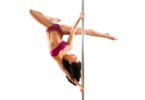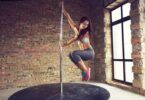Can you learn pole dancing at home? Absolutely! Pole dancing at home is an exciting and effective way to transform your body, build strength, and express yourself creatively. Pole dance workout at home is an exciting and effective way to transform your body. Don’t be fooled by the glamorous routines – pole dancing is a serious workout that challenges your core, sculpts your arms and legs, and leaves you feeling empowered and strong.
But before you start picturing yourself upside down in dazzling attire (we’ll get there!), let’s navigate the essential steps to set yourself up for a safe and successful pole dance workout at home.
Can You Learn Pole Dancing at Home? Essential Gear to Get Started
- The Star of the Show: Your Pole: Invest in a high-quality pole designed for home use. Make sure the height is adjustable to accommodate your space.
- Safety First: Crash Mats: These padded mats are crucial to cushion falls and minimize injuries. Opt for a thick pole dance mat that covers a good portion of the area around your pole.
- Grippin’ It and Rippin’ It: Grip Aids: Especially helpful for beginners, grip aids like liquid or lotion formulations enhance your grip on the pole. As your strength and technique improve, you may find these less necessary.
- Comfy Clothes: Choose breathable clothing that allows for a full range of motion. Leggings, sports bras, and shorts are ideal. Avoid loose clothing that could get caught on the pole.
- Dance Like No One’s Watching (Except Maybe Your Cat): Pick a space in your home with enough clearance for spins and climbs. Ideally, there should be a minimum of 5 feet of free space around the pole.
Finding the Perfect Learning Resources
Now that you’re decked out with the right gear, it’s time to hit the virtual dance floor! Here’s where the magic of online learning comes in. Numerous resources are available to guide you through pole dance training at home.
- Online Tutorials: YouTube is a treasure trove of free pole dance tutorials for all levels. Look for reputable channels with clear instructions and breakdowns of various moves.
- Paid Online Courses: Consider investing in paid online pole dance courses from qualified pole dance instructors. These courses often provide structured lesson plans, detailed technique explanations, and access to a supportive online community.
- Pole Dancing Apps: There are several apps specifically designed for pole dance training. These apps offer video tutorials, workout routines, and progress-tracking tools.
Tips to Safely Learn Pole Dancing at Home
- Warm Up, Cool Down, Repeat: Just any workout, a proper warm-up is crucial to prevent injuries. Focus on dynamic stretches and light cardio to get your blood flowing and muscles loose. Don’t forget to cool down with static stretches after your practice.
- Listen to Your Body: Pushing yourself is great, but pushing yourself to the point of pain is not. Be mindful of your limitations and take breaks when needed.
- Master the Basics Before You Fly: It’s tempting to jump straight into flashy spins and inverts, but building a strong foundation is key. Focus on mastering basic grips, climbs, and spins before progressing to more advanced moves.
- Spot a Friend (or Film Yourself): Having a friend spot you for tricky moves is ideal, but if you’re practicing solo, filming yourself can be helpful. Watch the playback to identify areas for improvement in your form.
Frequently Asked Questions:
- Do I need to be strong to start pole dancing? While some upper body strength is beneficial, you don’t need to be a gym rat to begin. Pole dance workout at home will help you build strength and endurance over time.
- Is pole dancing safe? Like any physical activity, pole dancing carries some risk of injury. However, focusing on proper technique, using safety equipment like crash mats, and listening to your body can
How to Build a Pole Dancing Routine at Home
Embrace the Challenge: A Sample Workout Routine
Ready to put your newfound knowledge to the test? Here’s a sample pole dance workout at home routine for beginners to get you started. Remember, this is just a starting point – feel free to adjust the exercises and duration based on your fitness level.
Warm-Up (5 minutes):
- Light cardio: Jumping jacks, jogging in place, jumping rope (3 minutes)
- Dynamic stretches: Arm circles, leg swings, torso twists (2 minutes)
Pole Workout (20-30 minutes):
- The Grip: Begin by familiarizing yourself with basic pole grips. Practice the static grip (holding the pole with both hands facing inwards) and the inverted grip (holding with both hands facing outwards). Spend a few minutes focusing on maintaining a secure hold.
- The Climb: Master the fireman climb, a foundational move that builds upper body strength. Wrap your legs around the pole, hook your inside knee under your arm, and use your arms to pull yourself up. Repeat on the other side.
- The Spin: Once comfortable with the grip and climb, try a basic spin. Stand with your back to the pole, reach behind and grasp it with one hand. Push off the floor with your leg and spin around the pole, keeping your core engaged. Aim for slow, controlled spins to begin.
- The Invert (Optional): For the brave souls ready for a taste of inversion, try the dead hang. Grasp the pole with a wide grip, kick your legs up, and engage your core to hold yourself in an inverted position for as long as comfortable. Remember, safety first!
Cool Down (5 minutes):
- Static stretches: Hold each stretch for 30 seconds (hamstrings, quads, chest, shoulders)
Building a Routine and Setting Goals
Pole dance training at home requires dedication and consistency. Aim for 2-3 sessions per week, with each session lasting at least 20 minutes. As you progress, you can gradually increase the duration and difficulty of your workouts.
Setting goals is key to staying motivated. Maybe you want to master a specific move, achieve a longer invert hold, or simply improve your overall strength and flexibility. Track your progress in a journal or fitness app to celebrate your achievements and stay inspired.
The Takeaway: More Than Just a Workout
Pole dance training at home is more than just a way to get fit. It’s a journey of self-discovery, a celebration of your body’s capabilities, and a creative outlet for expressing yourself. It’s about building confidence, pushing your limits, and feeling empowered. So, crank up the music, embrace the challenge, and get ready to pole dance your way to a stronger, happier you!








